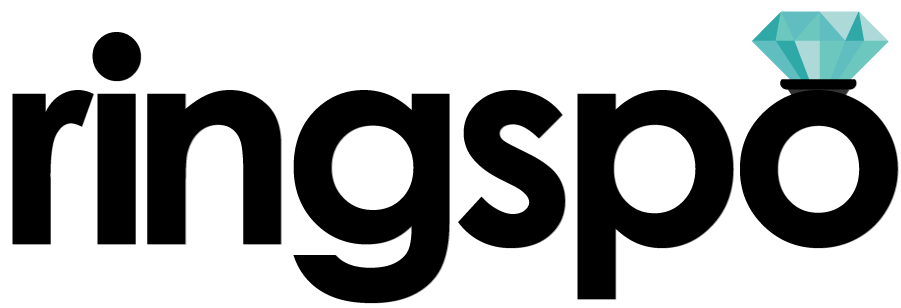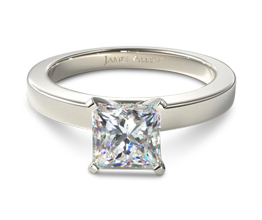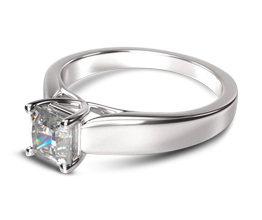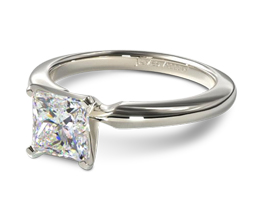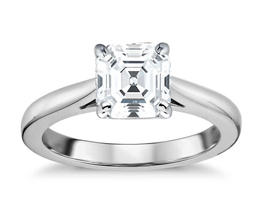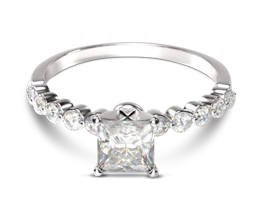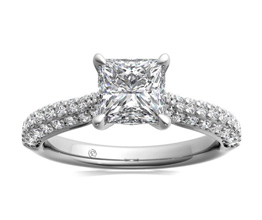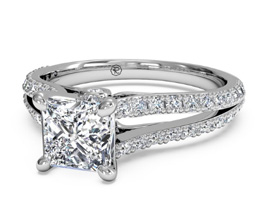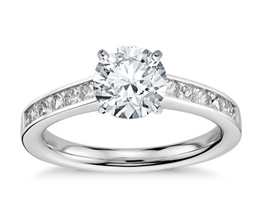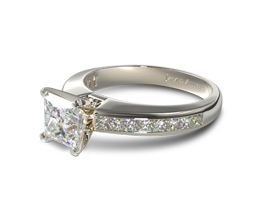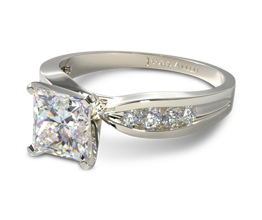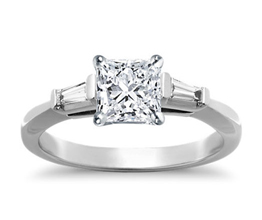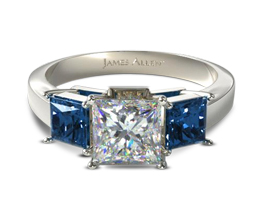Princess cut engagement rings
How to get the most beautiful princess cut diamond and the best value
Ringspo is reader supported
Ringspo is reader-supported, which means we may receive a commission if you click a link to a retailer & subsequently make a purchase.
We feature links to several retailers to help readers find the one that is the best fit for them. Find out more about how Ringspo works here.
Princess cut engagement rings are currently the second most popular style of ring for a couple of reasons – they’re very nearly as sparkly as round brilliant diamonds, but they’re almost always priced much lower. Because of their popularity there’s a huge range of setting styles available for Princess cuts, from the classic and simple solitaire setting, to impressive double-halo rings that sparkle from any angle.
On this page we’re going to look at:
- What’s good about Princess cut engagement rings
- What’s not so good about Princess cut engagement rings
- Princess cut engagement ring setting styles
- A Princess cut diamond buying guide to make sure you get the best rock possible
Do you really know about the 4Cs?
Much of the information on this page will focus on diamonds, as getting that right is key to getting an awesome ring for a great price. If you’re not familiar with the 4Cs of diamonds then I’d recommend reading this page which gives an overview of what you really need to know.
The Princess cut diamond shape was originally developed in the early ’80s as a modification of an existing square cut. Jewelers were starting to use lasers and computers to model how light was reflected by a diamond and were able to calculate a square shape that would reflect as much light as possible back, making the diamond sparkle brilliantly.
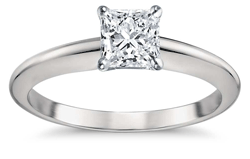
The Princess cut shape is also known as ‘modified square brilliant’ and the ‘brilliant’ part of the name doesn’t just mean that they are really, really good. ‘Brilliant’ is a technical jewelry term which indicates that the angles between the facets (sides) of the stone have been carefully calculated to reflect and sparkle as much as possible.
While the Princess cut isn’t quite as good at reflecting light as the ’round brilliant’ shape, diamond cutters have continued to research and optimize the Princess cut over the last 30 years, so that it now comes a very close second.
International Princess cut guides
Each country has its own retailers we’ve therefore created individual princess cut guides for different countries. If you live outside the US, click below to access your local guide:
Why Princess Cut Diamonds Make A Great Choice
Princess cut diamonds are well-priced
Princess cut diamonds are the second most popular shape after round brilliants, and this popularity means that there’s a large selection of stones available to choose from.

Diamond cutters choose some of the highest quality stones to be made into Princess cut diamonds, so if you know what to look for you can be sure to find a great stone that fits your required specs within your budget.
The table below shows the price difference at one of my recommended retailers between a round brilliant diamond, the most common shape and an princess cut diamond of the same size and quality:
- 1 carat
- Color F
- Clarity VS1
Here’s how they compare:
| SHAPE | PRICE (US$) | DIFFERENCE (US$) | DIFFERENCE (%) |
|---|---|---|---|
| Round Brilliant | 6,610 | ||
| Princess | 4,446 | -2,164 | -32.7 |
That’s a huge difference, especially considering that the Princess cut is considered to have ‘optical performance’ and sparkle very close to the round brilliant.
Although the exact difference will depend on the specs of the stone that you’re looking at, you can typically expect to save 25-33% on the price of a diamond by buying a princess cut than round brilliant of equivalent size and quality. Not too shoddy!
There are a number of factors that contribute to why the Princess cut is less expensive that the round, but a big one is that there is much less wastage of the original rough diamond when creating a princess cut.
An uncut diamond crystal in their natural state is an ‘octohedron’ shape, as seen below:
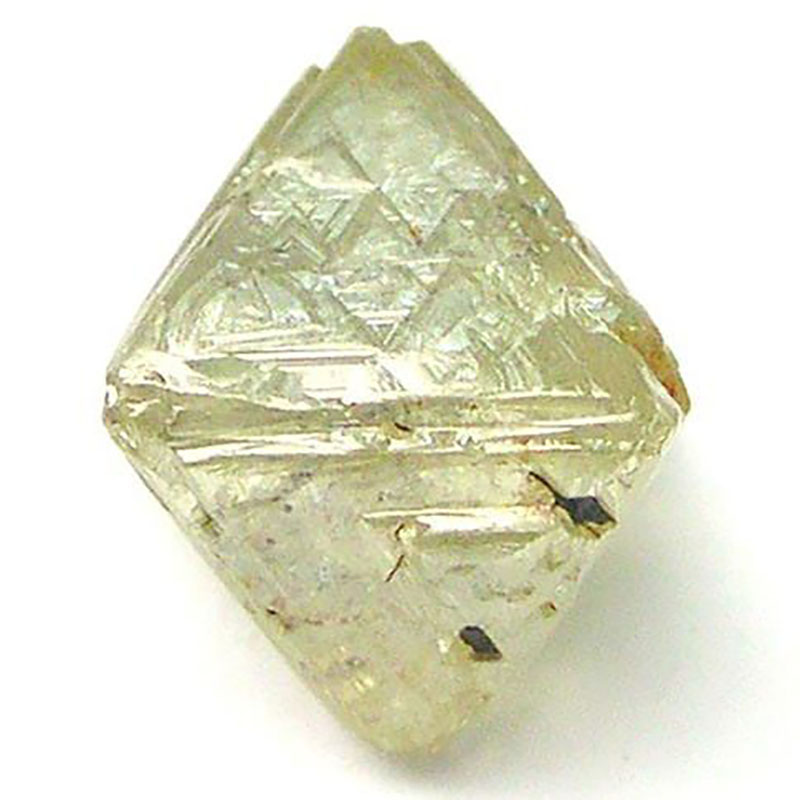
This is the shape that the diamond cutters begin to work with and a big part of their job is ensuring that as much of the rough stone is used as possible. Being efficient and reducing the amount of the rough stone that is wasted means that a larger finished stone can be produced, which allows them to sell the diamond for more money as carat weight is a big factor in the sale price of any diamond.
Diamond cutters love Princess cuts because they can get two high quality Princess cut diamonds from a rough diamond crystal with very little wastage:
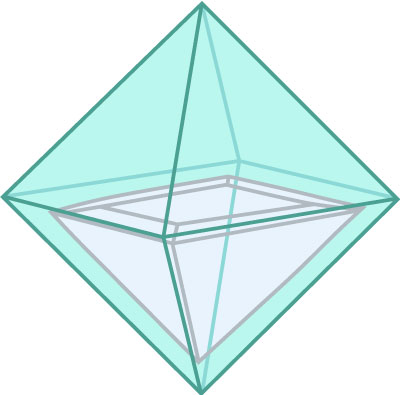
The pavilion angles of a Princess cut (the long, lower half of a diamond) mirror the rough cut stone’s angles very closely, so the cutters don’t need to trim away large areas like they do with the round brilliant. The round brilliant loses large portions of the corners of the rough diamond as the cutter trims it to the round shape.
While a Princess cut diamond may only lose 10-20% or the rough diamond, a round brilliant may lose up to 50%. So, for a given finished size, a diamond cutter has to start off with a much larger, and more expensive, uncut diamond crystal.
Princess cut diamonds sparkle brilliantly
A huge plus to the Princess cut’s excellent brilliance is that the fire and scintillation that you see as it reflects the light can help disguise flaws in the stone itself.
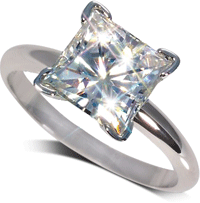
Minor inclusions and lower colour gradings will be hidden by the sparkle, which is definitely not the case for all diamond shapes. For shapes with less sparkle e.g. the emerald cut, you need to go for a higher quality, and therefore more expensive stone, as any imperfections in clarity or colour are much more likely to be visible.
Things to be careful of with Princess Cut Diamonds
Princess cut corners can be fragile
There aren’t many downsides to Princess cut diamonds, but one thing that you do need to be aware of is that their sharp corners and delicate girdle (the edge running around the stone) make them more susceptible to damage than a smooth-cornered shape like a round brilliant or an Asscher cut.

This shouldn’t be too much of an issue as the ‘prongs’ on most Princess cut diamond settings cover the corners, protecting them. When choosing your Princess cut setting though, good corner coverage is something to look out for.
Princess cut diamonds look smaller than round diamonds
Although the corner-to-corner measurement of a Princess cut is actually larger than the diameter of a round brilliant, they actually appear slightly smaller for a given carat weight.
As you can see on the image below because the Princess cut has to carry some of its weight in the corners, this leaves less weight available for the ‘spread’ ie. how tall and wide it is. Technically the surface area of a Princess cut is about 10% less than that of a round brilliant stone.

If visible size is something that you are concerned about and you are worried that going with a Princess cut may compromise on how big the stone looks, then you can alway increase the carat weight of the Princess cut stone slightly and still make a significant saving over a round brilliant stone that looks the same size.
Princess cut engagement ring settings
A big positive that results from the Princess cut’s popularity is that they’re available in a wide range of setting styles. This section will feature some of the most popular styles, but it’s by no means exhaustive.
This settings below are by no means a definitive collection, but is a selection to show the variety available within each setting style. If you see a setting style that you like, click through to find out more about it.
Princess cut solitaire settings
The first setting is the classic solitaire – the most popular setting style by far. Because it’s so simple, the solitaire is the least expensive ring setting you can buy. It doesn’t use a large amount of the precious metal in the setting and there are not additional diamonds to drive the price up.
The simple design puts maximum focus on the center stone, which means that you need to make sure that your rock is going to sparkle as much as possible!
Scroll across to check out a selection of princess cut solitaire engagement ring options, and click through to find out more about each one.
Princess cut pavé engagement rings
Pavé settings cover areas of the ring band in a large number of tiny diamonds, effectively ‘paving’ the ring with stones. This gives an incredible effect as the diamonds on the ring band will catch the light and shimmer at different angles to the center stone, making the whole ring sparkle.
There are many variations on pavé settings, each of which use a different number and size of diamonds – which can have a significant effect onthe price of the setting itself.
Princess cut channel set engagement rings
Channel settings are similar to pavé settings in that they add smaller diamonds to the band, but they are usually larger than the diamonds used in pavé settings, and are sunk into the band so that they sit flush.
Princess cut three stone settings
Adding side stones to a ring can be a great way to make sure that the center stone doesn’t need to do all of the impressing on its own.
An interesting way to make a princess cut three stone ring stand out is to mix up the shape, or even type, of side stones. One thing to note is that as you add additional stones to a ring, the cost of the setting increases, which decreases your budget for the center stone.
Princess cut halo engagement rings
If you’d like to add more bling to your ring then a halo setting is a great way to do it.
One thing to note is that with a setting like this, the large number of smaller diamonds does increase the price of the setting significantly. However, to balance it out you can choose a slightly smaller center stone without losing any impressiveness, as the rest of the ring will more than make up for it.
Princess cut diamond buying guide
Getting the right diamond can be the difference between proposing with an absolutely dazzling engagement ring and one that is merely… OK.
Not all diamonds are created equal, so this section will talk you through the 4Cs in relation to the Princess cut so that you can make sure you get an incredible stone. We’re going to look at:
- Cut
- Color
- Clarity
- Carat
Princess cut diamond cut quality
Diamond cut is the most important of the 4Cs, as it is the factor that has the biggest effect on how much light is returned to your eye. It’s the one area to definitely not scrimp on, as it will have the biggest effect on the impressiveness of your stone. Yes, even more that the carat weight!
Round brilliant stones have got a widely used grading scale for cut quality, developed by the Gemological Institute of America – the GIA – which allows stones to be graded on how well they have been shaped and as a result how much they will sparkle.
Unfortunately there’s no equivalent GIA grading scale of cut for Princess cut diamonds, which makes judgeing a stone’s cut quality more difficult, but definitely not impossible.
There is a grading scale for stones that have been certified by the AGS, although they are less widespread:
AGS Cut Grading
The AGS’s grading scale for Princess cut diamonds runs from 0-10, with 0 being the very best cut and 10 being the worst.
AGS uses lasers and computer modelling to ensuring that the their best stones perform as close to the benchmark round brilliant diamond as possible.
Although they are more difficult to find than GIA-certified stones, if you do find an AGS-certified stone then it will take a lot of the guesswork out of buying your Princess cut diamond. Only around 2% of stones are graded at the top level – 0 – and they are approximately twice the price of a regular Princess cut. Something to bear in mind if you are looking for the best performing stone!
Non-AGS cut grading
This doesn’t mean that there is nothing that you can do to judge the quality of a Princess cut diamond if you are looking at a non-AGS certified stone though. There are two more ratios that you can look at to make sure that you are getting a high quality stone with good brilliance and sparkle.
Princess cut diamond depth percentage
Depth percentage is the ratio of the depth to the width of the stone.
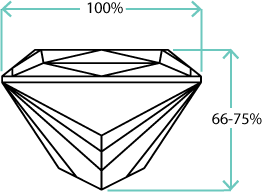
This is an important factor because if the stone is too tall it will let light leak out the bottom of the stone, and if it’s too shallow it will reflect light back at the wrong angle – both meaning that there is less light returned to your eyes, reducing the amount the stone appears to sparkle.
My recommendation for the best princess cut depth percentages are below:
| Excellent | Very good | Good |
|---|---|---|
| 66% – 75% | 64% – 76.5% | 62% – 78% |
Aim for a depth % in the ‘excellent’ range if possible, to ensure that your princess cut diamond sparkles brilliantly and looks its carat weight.
Princess cut diamond table percentage
The ‘table’ of a diamond is the large, flat area on the top of the stone. The size of the table in relation to the rest of the stone is important because the table is where the majority of light enters the stone. This needs to be carefully balanced with the other proportions to ensure that the correct amount of light enters the stone to allow for maximum sparkle. A larger table and more light is not always better.
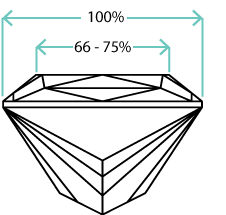
If you can, look for a Princess cut with a table percentage within the excellent range below, to ensure that you get the best sparkle. The ‘very good’ table range will also mean that your diamond will perform well.
| Excellent | Very good | Good |
|---|---|---|
| 66% – 75% | 64% – 77% | 62% – 79% |
The best way to use the above percentages is to enter them into the ‘advanced’ options on online jewelers search tools so that you only see stone that fit within the desirable specs. If you can, try and get ‘excellent’ for both depth percentage and table percentage to ensure that your stone sparkles as brilliantly as possible.
Length / Width Ratio
Although Princess cut diamonds are also known as the ‘modified square brilliant cut’, some jewelers definition of ‘square’ can be a little bit wobbly.
One of the big things to look at when buying a princess cut engagement ring is the ratio between the length and the width of the stone
A perfectly symmetrical stone would have a length:width ratio of 1:1 – ie. it’s a perfect square.
However, with some Princess cut engagement rings, this can be as high as 1: 1.10, which will actually be noticeably rectangular when worn. My recommendation is to go for a length : width ratio of 1:1.05 at the most.
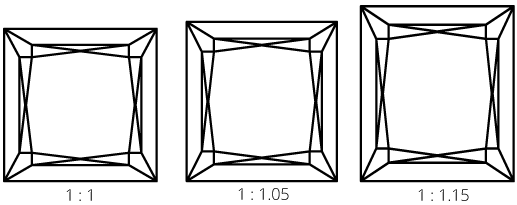
However, as with all things diamond, the less perfect something is, the lower it is priced, so if you are on a strict budget then you may find that there are bargains to be had by going with a higher length : width ratio.
The other circumstance where this can be made to work is if you are going to a setting with side stones, where the flanking stones will give the illusion of a wider center stone, and balance out the difference.
Polish
Diamond polish is a measure of the tiny imperfections that can get introduced to a diamond in the final finishing stages of the cutting process. They are usually microscopic marks, like the ‘abrasions’ seen on the right which are completely invisible to the naked eye.
Polish shouldn’t be a major factor in choosing your diamond, but it can be a way of choosing between two stones that are other wise very similar. Any stone with a polish grade of Excellent to Good will eye-clean though, so you can comfortably select within that range.

Princess cut diamond color
The brilliant cut nature of the Princess means that the light is sliced and diced and reflected back to you as sparkle and fire, which can contribute to hiding the true colour of the stone. This means that you can go slightly lower down the color grading scale and your stone will still look exceedingly white.
Color H is a great balance between colour and value. You can of course go higher, but it will not make a huge difference to the appearance of the diamond once it is set in a setting. Going for a D or an E color (the top grades) means that you are paying for the prestige of knowing that you have a top quality diamond, rather than any actual performance benefit.
Going lower than H will be a more affordable option, but you are more likely to be able to pick up the ‘warmer’ tones of the stone.
Color E – colorless, but expensive:
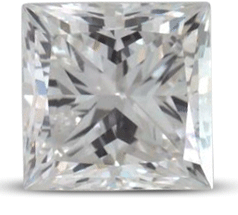
Color H – A great blend of white color and value:

Color J – Warm tones are much more visible:

Princess cut diamont clarity
Clarity is the least important of the 4Cs in terms of how the diamond actually looks. However, it’s often the 4Cs that jewelers make the biggest deal about. It’s easy to demonstrate clarity in a stone with a jeweler’s loupe (eyeglass) or microscope and show the difference between a VVS1 diamond and a VS2. However, in the real world these stone will look exactly the same and the other Cs (particularly cut) will have a far, far bigger effect on how dazzling your stone is.
For clarity on a Princess cut engagement ring, I recommend going with either a SI1 that you can see is eye-clean (some retailers offer high res images of each individual stone to allow you to check), or VS2 clarity to be extra safe.
One of my recommended retailers, Whiteflash, has the largest in-stock inventory of Ideal cut princess cut diamonds of any retailer in the US, all complete with images and videos so you verify that all are eye-clean and beautiful.
Princess cut diamond carat
Carat weight is something that people often get overly hung-up on. They want to choose a stone with a certain carat weight, even if it means that they end up making sacrifices on other, more important attributes of the ring.
The relationship between a diamond’s carat weight and its visible size isn’t always a direct one. When we judge a diamond’s size, we look at it from the top – known as the ‘face up’ position in the jewelry trade. However, much of the weight of a diamond is actually carried on the bottom half of the stone, where it can’t be seen.
The images below show the difference in size for Princess cut diamonds at a range of carat weights:

Hopefully you can see that increasing the carat weight doesn’t necessarily translate into a much visibly larger diamond. Changing the size from 0.8 carat to 1 carat is an increase in width of less than 0.4mm – less than 10%. However, the difference in price will be much more significant – almost a 100% increase.
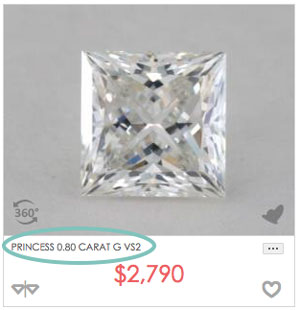
See today’s prices for a 0.8 carat Princess cut diamond here

Compare to prices for 1 carat Princess cut diamonds
The priority that you place on diamond carat weight and how bit you want to go is totally up to you. However, my recommendation is that you definitely don’t make it the most important attribute when choosing your engagement ring. Get the setting you love, find a diamond with a great cut that is going to sparkle brilliantly, make sure that it is eye-clean and has a good color and then see what carat weight you can fit into your budget.
A well-rounded diamond with excellent sparkle will much much more impressive than a big stone with obvious flaws.
Princess cut diamond certification
The fifth C, and a very important one too. When looking at any diamond, you need to ensure that any diamond that you’re looking at is a ‘cert stone’, which means that it has been assessed, graded and coded with a laser by an independent lab.
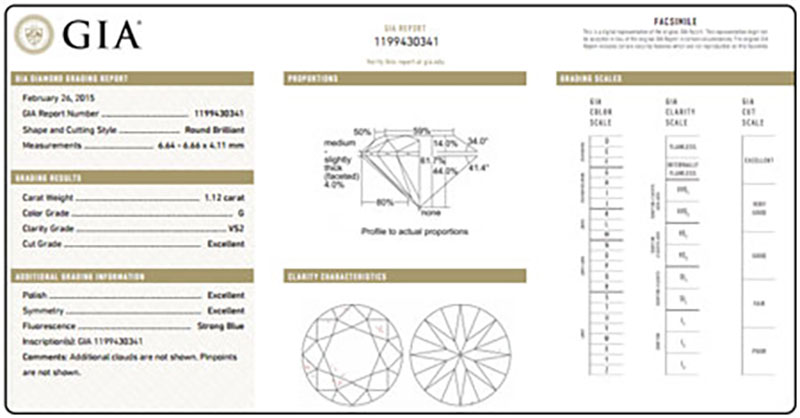
Each certificate has a unique report number and detailed information about the stone, covering the four Cs, the height, depth and other info. As well as providing assurance that the stone that you’re buying is the quality that you are paying for, a certificate also proves what you’re buying is not a substitute.
The lab to trust and to look for certification from is the non-profit Gemological Institute of America (GIA). It’s the most internationally recognised and generally seen as the most impartial of all of the gem labs.
The reason that the GIA is so well respected is because most others labs are part of trade bodies that contain jewelry retailers, or are ‘for profit’. While the GIA is very consistent with its gradings, the others have a reputation for being overly generous. What the GIA say is merely a diamond with a ‘good’ cut, maybe be graded ‘excellent’ by another lab, with an excellently large price to match.
Diamond certificates are what makes buying online safe and the best way to get a fantastic diamond at the lowest price. Knowing that each diamond you’re considering has been measured and graded by independent experts allows you to make an informed decision. You can take your time to consider the differences between diamonds and make sure you choose what experts have graded as the best stone, meaning that you get your perfect engagement ring at the best possible price.
Recommended specs
These specs are the minimum that we recommend to ensure that the diamond on your princess cut engagement ring looks fantastic.
You can of course go higher than these specs, if your budget allows, but for many of the characteristics you are paying for improvements that are very difficult, if not impossible, to see by the naked eye, especially when mounted in a ring setting.
If you’re unsure about what any of these terms mean, check out this page which talks you through them all.
Click below to visit our top recommended retailer and see the current selection available with our recommended specs:
| Clarity: | VS2 or SI1 |
| Colour: | H |
| Table %: | 66% – 75% |
| Depth %: | 66% – 75% |
| L/W ratio: | 1.00 – 1.05 |
| Certifying Lab | GIA or AGS |
| Cut: | AGS Ideal |
